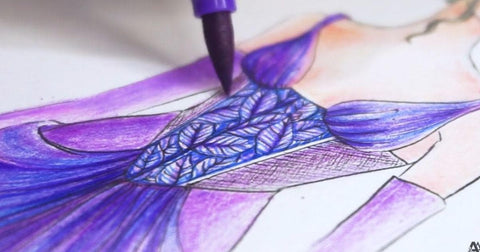The Art of Layering: Tips and Techniques for Building Depth and Dimension in Your Artwork
Last Updated: August 8, 2025

“I do not plan any painting, but begin with layers of textures and colors. As I layer the colors, something is suggested to me from within, and that is how it evolves.” — Katherine Dunn
Mastering the art of layering is comparable to discovering a hidden passage – one that opens into a world of depth and dimension that enhances your artwork. Whether you are a painter, illustrator, or mixed-media enthusiast, the skill of layering is a powerful tool that can elevate your creations.
Within this blog post, we have compiled 7 techniques to assist you in harnessing the magic of layering in your artistic pursuits, along with additional tips on how to get started with layering.
Before we dive into advanced layering techniques, it's crucial to grasp the fundamentals first.
Understanding the Basics

Layering, in the context of visual arts, refers to the creation of images by stacking individual elements on top of each other within a composition. This technique started with traditional art forms and has now become particularly prominent in digital art and graphic design.
In painting, artists may use glazes or apply multiple layers of paint to create depth, texture, and visual interest in their work. Each layer interacts with the layers beneath it, contributing to the overall complexity of the piece.
The ability to manipulate and control layers is a powerful tool for artists. It provides a level of flexibility that allows for experimentation and fine-tuning during the creative process.
7 Traditional Layering Techniques

Here are some traditional art layering techniques you might find useful:
1. Glazing
The process of glazing involves the application of thin, transparent coats of paint onto previously dried layers. This method is commonly used to enhance the vibrancy of colors and create a radiant outcome.
How to Do It: Allow each layer to dry completely before applying the next. Experiment with different colors to achieve the desired hue and depth.

2. Watercolor Lifting
Watercolor lifting involves applying layers of watercolor, followed by the removal or blotting of specific sections of the paint to reveal the layers beneath. This artistic technique is often used to create highlights.
How to Do It: Apply layers of watercolor, and while the paint is still wet or slightly damp, use a clean brush, sponge, or tissue to lift or blot areas of the paint.
Check out these 5 Must-Try Watercolor Techniques For Your Next Projects!
3. Sgraffito
Sgraffito is a method in which one scratches or scrapes through a layer of wet paint to reveal the layers beneath. This technique is often done to produce intricate textures or accentuate particular areas.
How to Do It: Apply a base layer of paint and let it partially dry. Then, use a tool like a palette knife or the end of a brush to scrape away parts of the top layer.
4. Collage

Collage is a creative process that involves arranging and affixing various materials such as paper, fabric, or other materials onto a surface. By employing this technique, artists are able to introduce texture and depth to their artwork.
How to Do It: Collect various materials with interesting textures and colors. Glue them onto your surface in layers, allowing each layer to dry before adding the next.
5. Mixed Media
Combining various materials like ink, pencil, charcoal, and more allows for diverse layering possibilities. Each material contributes its unique texture and quality.
How to Do It: Experiment with combining different materials on your surface. Consider layering ink over a pencil sketch or incorporating charcoal for added depth.

6. Underpainting
An underpainting refers to a monochromatic layer that acts as the foundation for subsequent layers of color. It establishes a base for the artwork and impacts the overall tone.
How to Do It: Choose a single color (usually a neutral tone) and create a preliminary layer. Once dry, build up subsequent layers of color over the underpainting.
7. Impasto
The Impasto technique involves the application of paint in thick, textured layers, resulting in a three-dimensional effect that adds physical depth to the artwork.
How to Do It: Use a palette knife or a brush to apply thick layers of paint. Experiment with different strokes and layering techniques to create texture.
To help you out with Impasto painting, here are five of The Best Tools for Creating Impasto Effects in Paint.

5 Tips to Build Depth and Dimension in Your Art
1. Start with a Strong Foundation
Like building a house, a solid foundation is essential for successful layering.
Begin with a well-thought-out sketch or underpainting that serves as the base layer. (We know, this is a little contrary to the quote you’ve read above, but it’s always great to have something to start with when you paint. Once you’ve practiced enough, you can eventually try freehand drawing and painting!)
This foundation will guide your subsequent layers, ensuring a harmonious and cohesive final piece.
2. Experiment with Blending
Blending techniques are a game-changer when it comes to layering. Apply layers of paint or color on a surface and then blend them by smearing, rubbing, or using blending brushes.
This helps achieve smooth gradations of color and value on objects and it creates seamless transitions between colors and values. The right amount of blending can add richness and complexity to your artwork.
Learn Blending Techniques with The Art of Ombré: Tips for Creating Beautiful Gradations of Color in Your Artwork
3. Use Masking for Precision
Masking allows you to create layered and intricate designs by covering parts of your painting. This allows precise control over where your layers are visible, which enables you to refine details and make seamless adjustments without altering the layer beneath.
4. Create Depth with Atmospheric Perspective
Employ atmospheric perspective by adjusting the color and contrast of layers to simulate the way distant objects appear fainter and cooler in color. This technique is particularly effective in landscape paintings, adding a sense of depth and distance.
5. Experiment with Various and Non-Traditional Media
One important thing you should remember is to not be afraid of experimenting. You can introduce texture overlays to your layers for added visual interest using traditional techniques like collage. You can also experiment with glazing to give your painting a beautiful, ethereal quality.
Finally, don't limit yourself to conventional tools. Explore the world of mixed media by incorporating unconventional materials into your layers like fabric, paper, or even digital elements in traditional artwork!
Give Your Art a Leg-Up with Layering Techniques

The art of layering is a nuanced and dynamic aspect of visual creation. These tips and techniques offer a range of possibilities for artists working with various mediums. With practice and patience, you can add richness and complexity to your artwork, resulting in pieces with depth and visual intrigue.
Remember, the key is experimentation. Allow yourself the freedom to explore and discover new ways to use layers to bring depth and dimension to your artwork. And yes, don’t be afraid to make mistakes, even if it’s one of these 5 common mistakes when painting with gouache. It’s a learning process, and you’ll only get better at it.
If you’d like more ideas and artistic inspiration, The Creative Corner is always open for you. Creativity awaits!






